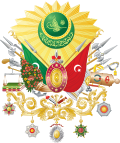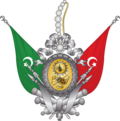The culture of the Ottoman Empire evolved over several centuries as the ruling administration of the Turks absorbed, adapted and modified the various...
32 KB (3,886 words) - 00:52, 23 April 2024
The Ottoman Empire, historically and colloquially known as the Turkish Empire, was an empire centred in Anatolia that controlled much of Southeast Europe...
164 KB (17,089 words) - 11:12, 15 October 2024
The Ottoman Empire used various flags and naval ensigns during its history. The crescent and star came into use in the second half of the 18th century...
16 KB (1,989 words) - 19:53, 23 September 2024
In the Ottoman Empire, women enjoyed a diverse range of rights and were limited in diverse ways depending on the time period, as well as their religion...
53 KB (7,004 words) - 21:03, 6 August 2024
the Ottoman Empire's millet system, Christians and Jews were considered dhimmi (meaning "protected") under Ottoman law in exchange for loyalty to the...
24 KB (3,014 words) - 01:18, 13 September 2024
organization of the Ottoman Empire Social structure in the Ottoman Empire Culture of the Ottoman Empire Science and technology in the Ottoman Empire Ottoman Turkish...
34 KB (1,607 words) - 13:18, 12 October 2024
The sultans of the Ottoman Empire (Turkish: Osmanlı padişahları), who were all members of the Ottoman dynasty (House of Osman), ruled over the transcontinental...
51 KB (3,173 words) - 11:12, 15 October 2024
The grand vizier of the Ottoman Empire (Turkish: Vezir-i Azam or Sadr-ı Azam (Sadrazam); Ottoman Turkish: صدر اعظم or وزیر اعظم) was the de facto prime...
95 KB (1,018 words) - 21:29, 12 October 2024
In the Ottoman Empire, a millet (Turkish: [millet]; Ottoman Turkish: ملت) was an independent court of law pertaining to "personal law" under which a confessional...
48 KB (5,793 words) - 19:28, 3 October 2024
Every sultan of the Ottoman Empire had his own monogram, called the tughra, which served as a royal symbol. A coat of arms in the European heraldic sense...
8 KB (704 words) - 21:21, 21 March 2024
The language of the court and government of the Ottoman Empire was Ottoman Turkish, but many other languages were in contemporary use in parts of the...
34 KB (3,572 words) - 07:17, 31 August 2024
The dissolution of the Ottoman Empire (1908–1922) was a period of history of the Ottoman Empire beginning with the Young Turk Revolution and ultimately...
76 KB (9,681 words) - 04:34, 29 September 2024
help. The Ottoman Empire used anthems since its foundation in the late 13th century, but did not use a specific imperial or national anthem until the 19th...
4 KB (357 words) - 12:08, 22 August 2024
The rise of the Ottoman Empire is a period of history that started with the emergence of the Ottoman principality (Turkish: Osmanlı Beyliği) in c. 1299...
76 KB (10,287 words) - 14:24, 18 October 2024
to Ottoman miniatures. Culture of the Ottoman Empire Persian miniature Mughal painting My Name Is Red, a historical-fiction novel involving Ottoman miniature...
26 KB (2,944 words) - 17:49, 18 June 2024
Ibrahim (/ˌɪbrəˈhiːm/; Ottoman Turkish: ابراهيم; Turkish: İbrahim; 5 November 1615 – 18 August 1648) was the sultan of the Ottoman Empire from 1640 until 1648...
31 KB (3,759 words) - 15:16, 8 October 2024
'Turkish art music') is the tradition of classical music originating in the Ottoman Empire. Developed in the palace, major Ottoman cities, and Sufi lodges...
56 KB (6,975 words) - 16:01, 15 October 2024
The Ottoman Empire developed over the years as a despotism[citation needed] with the Sultan as the supreme ruler of a centralized government[citation...
14 KB (1,785 words) - 17:01, 15 August 2024
The Ottoman coffeehouse, or Ottoman Café was a distinctive part of the culture of the Ottoman Empire. These coffeehouses, started in the mid-sixteenth...
36 KB (4,687 words) - 10:08, 18 January 2024
The military ranks of the Ottoman Empire may be visually identified by the military insignia used during the Military of the Ottoman Empire. Aghas were...
20 KB (555 words) - 22:13, 17 October 2024
in the Ottoman Empire was a major institution and a significant part of the Ottoman Empire's economy and traditional society. The main sources of slaves...
81 KB (10,548 words) - 16:20, 5 October 2024
The Ottoman Empire was founded c. 1299 by Osman I as a small beylik in northwestern Asia Minor just south of the Byzantine capital Constantinople. In 1326...
97 KB (11,776 words) - 14:24, 18 October 2024
Ottoman Empire signed the Treaty of Zuhab which recognized Iraq in Ottoman control, and decisively parted the Caucasus in two between the two empires...
8 KB (880 words) - 00:12, 24 October 2023
The military of the Ottoman Empire (Turkish: Osmanlı İmparatorluğu'nun silahlı kuvvetleri) was the armed forces of the Ottoman Empire. It was founded...
43 KB (4,451 words) - 00:14, 20 October 2024
Ulu Camii located at the first capital of the Ottoman Empire. Sunni Islam was the official religion of the Ottoman Empire. The highest position in Islam...
4 KB (395 words) - 15:16, 8 August 2023
The partition of the Ottoman Empire (30 October 1918 – 1 November 1922) was a geopolitical event that occurred after World War I and the occupation of...
30 KB (3,782 words) - 11:03, 18 October 2024
significant minority in the Ottoman Empire. They belonged to either the Armenian Apostolic Church, the Armenian Catholic Church, or the Armenian Protestant...
43 KB (4,770 words) - 20:54, 30 September 2024
By the time the Ottoman Empire rose to power in the 14th and 15th centuries, there had been Jewish communities established throughout the region. The Ottoman...
50 KB (5,997 words) - 01:30, 13 October 2024
Tulip Period (redirect from Tulip Era in the Ottoman Empire)
21 July 1718 to the Patrona Halil Revolt on 28 September 1730. This was a relatively peaceful period, during which the Ottoman Empire began to orient...
10 KB (1,323 words) - 23:39, 17 June 2024
Phanariots (category Culture of the Ottoman Empire)
important positions in the Ottoman Empire: Voivode of Moldavia, Voivode of Wallachia, Grand Dragoman of the Porte and Grand Dragoman of the Fleet. Despite their...
34 KB (3,852 words) - 10:03, 3 October 2024

















